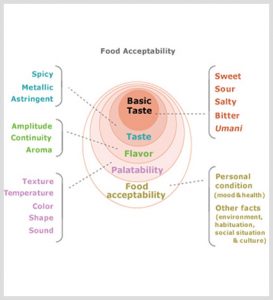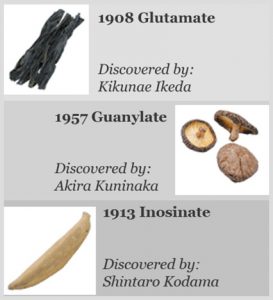When we taste foods, we experience the sensation of deliciousness using all of the five senses such as smell, sight and touch. Of course, taste is the deciding factor. The important elements of food acceptability are the tastes, “sweet” “sour”, “salty” ,”bitter”, and “umami”, which are known as the basic taste. A basic taste is an independent taste which can not be created even though the combination of other taste. Among basic taste, umami was discovered in 1908 by Dr.Kikunae Ikeda, He focused on the taste kombu dashi (soup stock of kelp), and revealed that the component of taste is glutamate. He named this taste “umami”.
What is Umami

One of the basic tastes

The tongue has receptors for umami substances.
The surface of the tongue has three types of taste papillae, and each papilla has taste buds. It is said that adults have between approximately 7,500 and 12,000 taste buds.Taste buds are composed of taste cells, which have taste receptors on their surface. Receptors receive taste substances. The human tongue has mechanisms to detect the basic tastes of sweet, sour, salty, bitter, and umami, and transmits information regarding taste to taste nerves. The existence of these receptors indicates the necessity to physiologically recognize the five basic tastes. The academic community has acknowledgedumami as a basic taste due to the fact that, as with other basic tastes as well, there is a specific receptor for detecting umami and its signal is transmitted to the brain by a taste nerve.

Major Umami Substances.
There are three major umami substances: glutamate, inosinate, and guanylate. Glutamate is a common amino acid found abundantly in nature. Nucleotides that contribute the most to umami taste, inosinate and guanylate, are also present in many foods. These major umamisubstances were discovered by Japanese scientists, and now umamitaste is a universal taste in various foods in the world.





